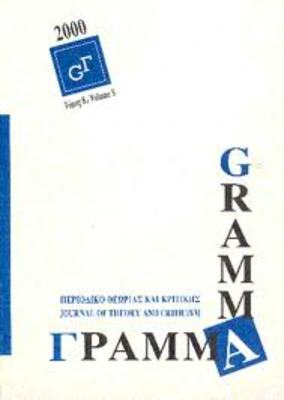At the Cutting Edge Between Semiology and Phenomenology : Performances of Orlan and Franko B*
Part of : Γράμμα : περιοδικό θεωρίας και κριτικής ; Vol.20, 2012, pages 260-272
Issue:
Pages:
260-272
Author:
Abstract:
The body – whether it is seen as being a material, substantive entity or dematerialised,semiotic sign, or even a technological abstraction – is alwayscaught up in a discourse at the intersection of art, technology and body politics,where social and political structures are often (re)enacted and (re)producedthrough individual acts and practices. The machinic body, genderedbody, historicised body, performing body, fragmented body, objectifiedbody, phenomenological body and the body in pain all point to the ineluctable,historical discursivity surrounding the body, from a Western metaphysicsof presence to a de-subjectified semiotics to a postmodernist revisionof notions of embodiment, where the body (as well as identity) is relegatedto fictive, dialogical or constantly emerging and shifting positions.This paper aims to show how the artistic practices of the bodily-based performanceartists Orlan and Franko B, who theatrically cut and refashiontheir bodies in front of a large audience through the use of machinic andtechnological devices, attempt (and yet fail) to stretch the body’s boundariesand to collapse the material body into the abstract body-machineimagecomplex by merging life and machinic processes. It also points tothe very real limits of using semiology as a hermeneutical system.
Subject:
Subject (LC):
References (1):
- Ashby, Imogen. “The Mutant Woman: The Use and Abuse of the Female Body in PerformanceArt”. Contemporary Theatre Review 2000, 10.3 (Malaysia, OPA: 2000):39-51. Print.Auslander, Philip. From Acting to Performance: Essays in Modernism and Postmodernism.London and New York: Routledge, 1997. Print.Badmington, Neil. “Introduction: Approaching Posthumanism”. Posthumanism. Ed.Neil Badmington. Basingstoke, New York: Palgrave, 2000. 1-10. Print.Ballard, J.G. Crash. London: Vintage, 1995. Print.Beaujour, Michel. “A Propos of a Separation in Julia Kristeva’s La Révolution du LangagePoétique”. The Kristeva Critical Reader. Ed. John Lechte and Mary Zournazi.Edinburgh: Edinburgh University Press, 2003. 15-35. Print.Bennett, Susan. Theatre Audiences: A Theory of Production and Reception. 2nd edition.London & New York: Routledge, 1997. Print.Bianchi, Emanuela. “Receptacle/Chora: Figuring the Errant Feminine in Plato’sTimaeus”. Hypatia 21.4 (2006): 124-44. Print.Butler, Judith. Gender Trouble: Feminism and the Subversion of Identity. London andNew York: Routledge, 1990. Print.Connor, Steven. The Book of Skin. London: Reaktion Books, 2004. Print.Deleuze, Gilles. Difference and Repetition. Trans. Paul Patton. London and New York:Continuum, 2004. Print.Deleuze, Gilles and Félix Guattari. Anti-Oedipus: Capitalism and Schizophrenia. Trans.Robert Hurley, Mark Seem and Helen R. Lane. London: The Athlone Press, 1984.Print.Derrida, Jacques. “Signature Event Context”. Margins of Philosophy. Trans. Alan Bass.Chicago: Chicago University Press, 1982. 309-330. Print.Doyle, Jennifer. “Critical Tears: Franko B’s ‘I Miss You’”. Franko B: Text. 2005. Web.5 February 2012. <http://www.franko-b.com/text3.htm>Ellmann, Maud. “Introduction”. Psychoanalytic Literary Criticism. London & NewYork: Longman, 1994. 1-35. Print.Habermas, Jürgen. Knowledge and Human Interests. Trans Jeremy J. Shapiro. Cambridge:Polity Press, 1987. Print.Halberstam, Judith. Skin Shows: Gothic Horror and the Technology of Monsters.Durham and London: Duke University Press, 1995. Print.Harris, Geraldine. Staging Femininities: Performance and Performativity. Manchester:MUP, 1999. Print.Hodge, Joanna. “Feminism and Postmodernism: Misleading Divisions Imposed by theOpposition between Modernism and Postmodernism”. The Problems of Modernity:Adorno and Benjamin. Ed. Andrew Benjamin. London and New York: Routledge,1989. 86-111. Print.Lacan, Jacques. Έcrits: A Selection. Trans. Alan Sheridan (London & New York: Routledge,2003. Print.Lowry, Joanna. “Performing Vision in the Theatre of the Gaze: the Work of DouglasGordon”. Performing the Body/Performing the Text. London & New York: Routledge,1999. 273-282. Print.Margaroni, Maria. “‘The Lost Foundation’: Kristeva’s Semiotic Chora and Its AmbiguousLegacy”. Hypatia 20.1 (Winter 2005): 78-98. Print.Mitchell, Juliet. Mad Men and Medusas. New York: Basic Books, 2000. Print.Oliver, Kelly. “The Crisis of Meaning”. The Kristeva Critical Reader. Ed. JohnLechte and Mary Zournazi. Edinburgh: Edinburgh University Press, 2003. 36-54. Print.Plato. The Republic. 360 B.C.E. Trans. Benjamin Jowett. The Internet Classics Archive.Web. 5 January 2012. <http://classics.mit.edu/Plato/republic.html>––. Timaeus. 360 BC. Trans. B. Jowett. Web. 12 January 2012.<http://www.ellopos.net/elpenor/physis/plato-timaeus/default.asp>Pontalis, J. B. Frontiers in Psychoanalysis: Between the Dream and Psychic Pain.Trans. Catherine Cullen and Philip Cullen. London: The Hogarth Press, 1981.Print.Sanchez-Eppler, Karen. “Bodily Bonds: The Intersecting Rhetorics of Feminism andAbolition”. The New American Studies: Essays from Representations. Ed. PhilipFisher. California: University of California Press, 1991. 228-259. Print.Scarry, Elaine. The Body in Pain: The Making and Unmaking of the World. New Yorkand Oxford: Oxford University Press, 1985. Print.Seltzer, Mark. Serial Killers: Death and Life in America’s Wound Culture. New York& London: Routledge, 1998. Print.Smith-Di Biasio, Anne-Marie. “Emerging Phantom-Like from Some Other Reality:Thinking Back and the Apparition of the Feminine”. Paragraph 32.2 (2009): 214-225. Print.Sobchack, Vivian. “Baudrillard’s Obscenity”. Science Fiction Studies 18.3 (November 1991).Web. 11 July 2011. <http://www.depauw.edu/sfs/backissues/55/forum55.htm>Wray, B. J. “Performing Clits and Other Lesbian Tricks: Speculations on an Aestheticsof Lack”. Performing the Body/Performing the Text. London & New York: Routledge,1999. 186-198. Print.




